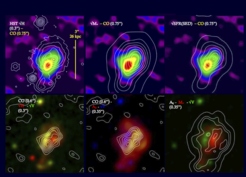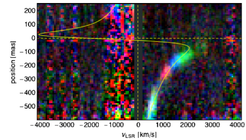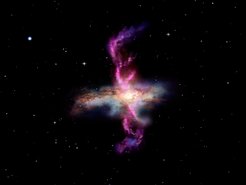News and Recent Results of the MPE Infrared/Submillimeter Group
Molecular Gas, Extinction, Star Formation, and Kinematics in the z = 1.5 Star-Forming Galaxy EGS130111661

In the top row, the molecular gas is shown as the backdrop image in color and the contours display the stellar light (from left to right: H-band map, stellar mass, and extinction-corrected star formation rate). In the bottom row (center image), the backdrop shows the extinction, and the white contours show the CO-integrated flux map – demonstrating how well the absorption seen in the rest-frame optical light coincides with the CO emission. The high-resolution HST H-band maps show clumps of star formation, typical for galaxies at the peak of the cosmic star formation rate (see results from the high-redshift galaxy survey SINS).

This image shows a comparison of CO (IRAM/PdB) and Hα (LBT/LUCI) data at the same resolution of FWHM 0.75 arcseconds. There is a remarkable agreement between the kinematics as derived from the molecular (traced by the submm CO line) and ionized gas (traced by the Hα line) that shows that both tracers can be used equally well to study rotation curve and kinematics in high-redshift galaxies.
As a follow-up to the high-redshift molecular gas survey PHIBSS (Tacconi et al. 2013; see news item below), we carried out a detailed analysis of one of the most massive galaxies in this survey. For the study of the galaxy named EGS13011166, CO 3-2 line observations from the IRAM Plateau de Bure millimeter interferometer were combined with Large Binocular Telescope (LBT) LUCI observations of the Hα line in this galaxy, at matched spatial resolutions of 0.75 arcseconds. The galaxy was scanned perpendicularly to the slit with LUCI to obtain spectra that are spatially resolved both along and perpendicular to the slit. Additionally, we used Hubble Space Telescope (HST) V-, I-, J-, and H-band maps. Together, these data allow us to derive the stellar surface density and star formation rate, molecular gas surface density, optical extinction, and gas kinematics.
More information: Research paper: Genzel et al. 2013, ApJ, 778, 68
New Observations on the Galactic Center Gas Cloud "G2"
September 12, 2012
New observations on the gas cloud "G2" falling toward the Galactic Center confirm its highly elliptical orbit, but with updated orbital parameters. As new data show, the cloud is now expected to come even closer – the updated pericenter distance is 2200 Schwarzschild radii – to the supermassive black hole at the center of our galaxy. While its origin is still unclear, its apocenter is near the inner edge of the disk of young stars. This supports speculations that the cloud, which has a mass of only about three earth masses, originated as a wind of one of these stars.

In the course of this year, we have planned more observations of the cloud, of course, and not only in the infrared area. Many groups have started campaigns to observe this accretion event in the whole electromagnetic spectrum. A wiki page has been set up to collect all information on "G2."
More information: Research paper: Gillessen et al. 2013, ApJ, 763, 78
Galactic Black Hole Disrupts Gas Cloud
December 14, 2011

Image: MPE
Over the next few years, astronomers will be able to observe first-hand how the supermassive black hole at the center of our Milky Way is being fed: an international team of astronomers led by the Max Planck Institute for Extraterrestrial Physics has found a gas cloud that is falling toward the black hole in the Galactic Center. While some distortion due to the huge gravitational pull of the black hole can already be seen, the gas cloud will be completely disrupted and ultimately swallowed by the black hole, resulting in largely increased X-ray emission. The observations and analysis are described in a Nature paper, published online on December 14, 2011.
More information: MPE press release
Caught in the Act: Herschel Detects Gigantic Storms Sweeping Entire Galaxies Clean
May 9, 2011

Image: MPE
With observations from the PACS instrument on board the ESA Herschel space observatory, an international team of scientists led by the Max Planck Institute for Extraterrestrial Physics has found gigantic storms of molecular gas gusting in the centers of many galaxies. Some of these massive outflows reach velocities of more than 1,000 km/s, i.e., they are thousands of times faster than the ones in terrestrial hurricanes. The observations show that the more active galaxies contain stronger winds, which can blow away the entire gas reservoir in a galaxy, thereby inhibiting both further star formation and the growth of the central black hole. This finding is the first conclusive evidence for the importance of galactic winds in the evolution of galaxies.
More information: MPE press release




